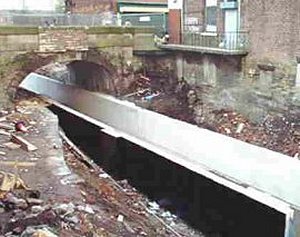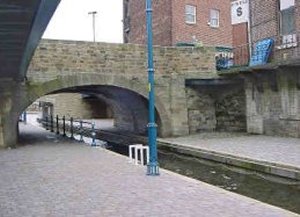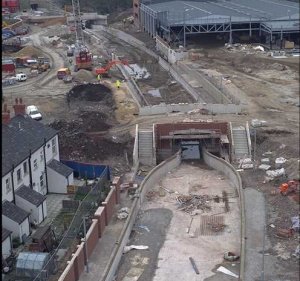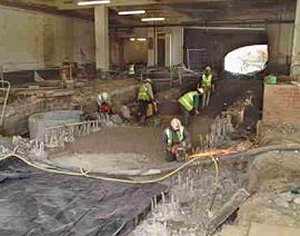Was the 'Narrow' opened too early?
Article Index
ALREADY this month there have been three closures of the Huddersfield Narrow Canal, continuing the ever continuing closures of the waterway, writes narrowboatworld Editor Tom Crossley.
There was the lock closure that caused the couple to be forced off the official moorings at Milsbridge (Hounded off moorings), then the canal was closed on the 15th when a wall collapsed and today (23rd) we learn that Lock 6 has problems with its cill and is closed.
 Through navigation
Through navigation
It was way back in 1974 that the Huddersfield Canal Society was formed by a group of enthusiasts with the ambitious aim of restoring the then derelict Huddersfield Narrow Canal to through navigation from the Aston and Peak Forest canals to the northern canals of Yorkshire and Lancashire via the Calder & Hebble Navigation.
The above picture shows Melbourne Street in Stalybridge with its new channel and the picture below shows it all completed.
 In the 1990s money was freely available for restoration, with the then British Waterways making full use, with the Kennet & Avon, Rochdale and Huddersfield Narrow canals all receiving money—£32 millions in the case of the Huddersfield Narrow, and all being fully restored. Such were the funds available that the Link between the Ribble and Lancaster Canal was built and the derelict Anderton Boat Lift was also fully restored.
In the 1990s money was freely available for restoration, with the then British Waterways making full use, with the Kennet & Avon, Rochdale and Huddersfield Narrow canals all receiving money—£32 millions in the case of the Huddersfield Narrow, and all being fully restored. Such were the funds available that the Link between the Ribble and Lancaster Canal was built and the derelict Anderton Boat Lift was also fully restored.
The picture below shows the waterway being installed through Stalybridge.
 Funding
Funding
The funding in that hey-day of restoration was mainly from the Millennium Lottery Fund and English Partnerships, with various smaller contributions from the various councils, societies and British Waterways. But after such successes, too many others realised money was available and so the cash dried-up, with the next big restoration of the Cotswold Canals getting very little and its complete restoration now in doubt.
It was in May 2001 that restoration work on the Huddersfield Narrow was completed with its official opening ceremony by HRH the Prince of Wales in September that year.
 'The Impossible Dream'
'The Impossible Dream'
Its restoration was termed 'The Impossible Dream' as the task involved work the like of which had never been accomplished before, building a new section of waterway through Stalybridge Town Centre and even moving a factory in Huddersfield to build a tunnel underneath, (pictured) then replacing the factory over the top.
Then there was the restoration of the Standedge Tunnel that at 5,700 yards is the longest canal tunnel in the country—itself a great undertaking, that acts as the summit pound of the waterway.
 It is the tunnel that however restricts the use of the waterway as every boat has to have a 'chaperone', the best known of them being 'Fred' who gives a knowledgeable running commentary through the whole distance. The problem is that this has been restricting the number of boats allowed through the tunnel to no more than nine a week. And of course many boaters quell at the thought of the 84 locks over a distance of under 20 miles. The unusual photograph above shows our boat nearing the western entrance of Standedge Tunnel in 2011.
It is the tunnel that however restricts the use of the waterway as every boat has to have a 'chaperone', the best known of them being 'Fred' who gives a knowledgeable running commentary through the whole distance. The problem is that this has been restricting the number of boats allowed through the tunnel to no more than nine a week. And of course many boaters quell at the thought of the 84 locks over a distance of under 20 miles. The unusual photograph above shows our boat nearing the western entrance of Standedge Tunnel in 2011.
Problems at the start
There were problems with the building of the canal at its very start, with progress slow and very erratic. Its builder, Benjamin Outram, was seriously ill for long periods whilst the waterway was being constructed, leaving it with no overall administration. The company was short of money as the the costs had been seriously underestimated and shareholders were not honouring their pledges.
It is well recorded that there were instances of poor workmanship in the building of the waterway, with both reservoirs and the canal itself failing and locks not up to standard, causing problems throughout its working life. The picture shows moored boats left high and dry when a pound drains away overnight.
Hastily completed
During the restoration many of the locks were hastily completed and gave problems, as when we cruised it the first time in 2003, there were three instances where staff had to be called out to assist. At one lock we were told to fasten a rope around a top gate and pull it open with the boat, as the lock would not fill for the water to be level!
 At that time the short pounds were obviously very silted, as one boat we were following was stuck every time water was let out of a lock, with walkers following it along pushing the boat out into deep water! The picture shows the colossal amount of silt in the waterway.
At that time the short pounds were obviously very silted, as one boat we were following was stuck every time water was let out of a lock, with walkers following it along pushing the boat out into deep water! The picture shows the colossal amount of silt in the waterway.
Second time
The second time we cruised the waterway, in the opposite direction, such was the leakage that we had to have Fred accompany us for lock after lock as pounds were too low to negotiate. As those who have cruised the waterway know, the locks being close together means that pounds are exceptionally short and, not being dredged, do not hold enough water. The picture below shows Jan and Fred waiting for the pound to fill so that our boat could exit the lock over the cill.
 So silt again was a problem, with all too often our boat becoming fast even when entering locks where silt had built up over the years.
So silt again was a problem, with all too often our boat becoming fast even when entering locks where silt had built up over the years.
The problem
The problem is obviously that the canal was opened too early after restoration. It should have been thoroughly dredged, the leakage attended to and lock gates made to fit correctly. Alas with Canal & River Trust now in charge, none of this will happen, and there is a real chance of it being closed once again.
 This will be a great pity, as the Huddersfield Narrow takes you though the glorious scenery of the Pennines. Also, working through all those locks is somewhat of an adventure and being able to now steer the boat yourself through that remarkable engineering achievement of the Standedge Tunnel is an experience like no other, and is highly recommended.
This will be a great pity, as the Huddersfield Narrow takes you though the glorious scenery of the Pennines. Also, working through all those locks is somewhat of an adventure and being able to now steer the boat yourself through that remarkable engineering achievement of the Standedge Tunnel is an experience like no other, and is highly recommended.
It will be tragic if it is continuously neglected, and it is lost once again.

